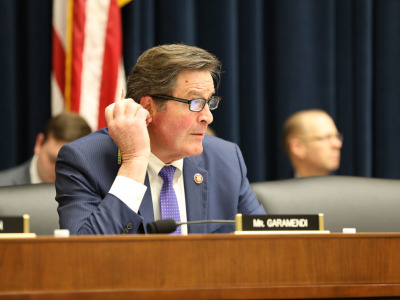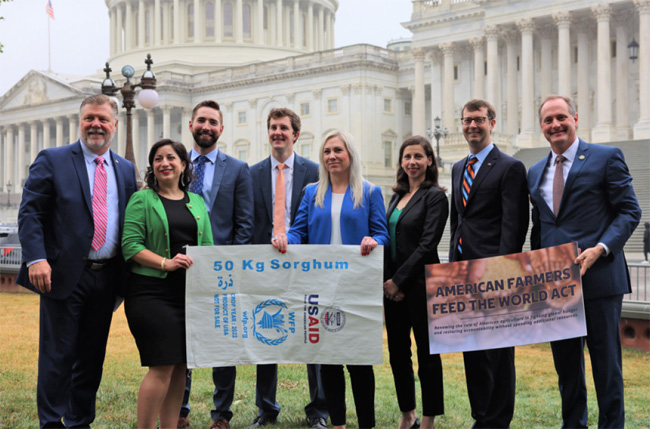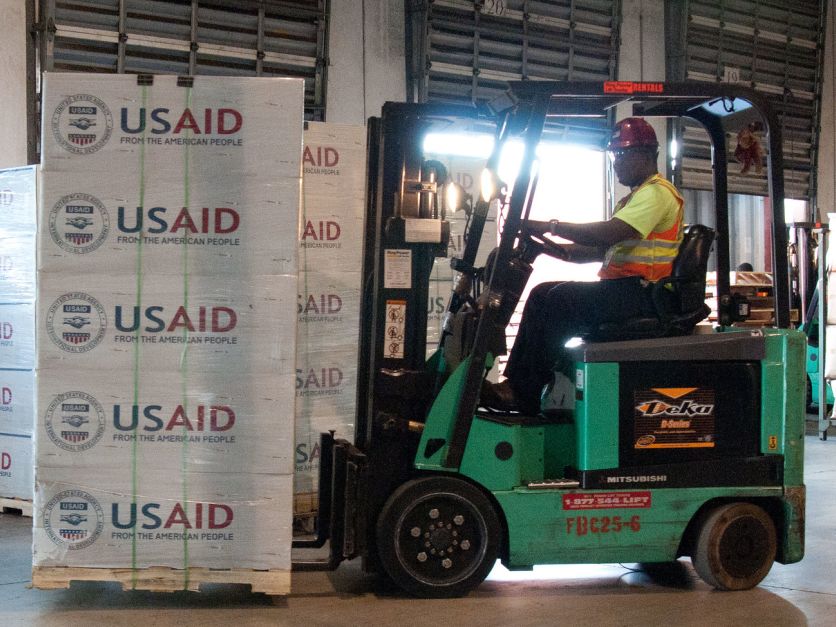A bipartisan group of House members want to use the next farm bill to stop the government from being able to use the Food for Peace program to provide international food assistance in the form of cash or commodities grown outside the U.S.
A recently introduced measure, the American Farmers Feed the World Act, that the lawmakers want in the farm bill would restrict Food for Peace - also known as P.L. 480 Title II - to U.S-grown commodities.
In fiscal 2022, the U.S. Agency for International Development paid about $2.6 billion to ship 1.8 million metric tons of wheat, rice, soy products and other U.S.-grown commodities to feed 53 million people in 21 countries, according to USAID data.
Some lawmakers and farm groups say the legislation is needed to ensure American crops aren’t replaced by cash assistance and foreign commodities in Food for Peace, but humanitarian groups say the bill could be catastrophic for those in need.
“Congress always intended for these foreign relief programs to be a triple bottom line: A win for America’s farmers in years when they grow more than they can sell,” said Rep. John Garamendi, D-Calif., who introduced the House version of the bill last week with Reps. Tracey Mann, R-Kan., Rick Crawford, R-Ark., and Jimmy Panetta, D-Calif.
Garamendi called the legislation “a win for projecting the generous spirit of Americans to help those starving around the world. Our bipartisan bill restores this careful balance to ensure that taxpayer dollars for foreign relief are spent on American-grown foods transported on U.S.-flag vessels, not foreign alternatives.”
 Rep. John Garamendi, D-Calif.
Rep. John Garamendi, D-Calif.
Farm groups like the National Association of Wheat Growers, USA Rice Federation, American Soybean Association and the American Farm Bureau Federation were quick to throw their support behind the bill that would guarantee that at least half of the Food for Peace budget goes toward procuring American-grown commodities and the related costs for ocean freight.
“Our nation's farmers have a long and storied history supporting these vital humanitarian efforts around the world, and this legislation helps keep the American farmer at the center of America's international food aid policies," Amy France, vice chair of the National Sorghum Producers, said in a statement.
But while farm groups are rallying behind the bill, humanitarian groups that do much of the work in foreign countries to distribute U.S.-sponsored food aid assert the legislation would deprive desperately needed assistance from millions of people.
“The legislation subverts the mandate of Food for Peace Title II and would make it nearly impossible to implement resilience-building programs that help communities feed themselves and bounce back from stresses like droughts or price shocks,” Catholic Relief Services, Mercy Corps, Oxfam America, Action Against Hunger, Bread for the World and other groups noted in a joint statement.
Shiploads of U.S. wheat, rice and more are needed for international emergency aid, but sometimes it's necessary to work with local farmers to develop their own crop value chains and build resilience, said Barrett Alexander, director of policy and advocacy for Mercy Corps.
The House bill – designed to be “marker” legislation for inclusion in the next farm bill – would remove all funding in P.L. 480 Title II for cash assistance or local and regional purchases.
“American food aid should be produced in America,” said Crawford, a senior member of the House Agriculture Committee. “It is disingenuous to continue to use funds to purchase foreign commodities and call it ‘American aid.’ No one knows the business of feeding the world better than American farmers.”
But anti-hunger organizations stress that the vast majority of Food for Peace funding already goes toward buying U.S. commodities and shipping them overseas.
In FY22, 36% of Title II funding was used to buy and bag commodities like wheat, vegetable oil, lentils, pulses and cornmeal, while another 10% paid for ocean freight and 23% for transportation in foreign countries as well as storage and handling. Just 0.39% went toward cash assistance or buying commodities in or near the countries where aid was needed, according to USAID.
USAID has a separate account, the Emergency Food Security Program, that enables humanitarian organizations to purchase food near or in an affected country or to provide cash or vouchers to needy people to purchase their own food.
Although cash assistance and local and regional purchasing accounts for a tiny percentage of Food for Peace spending, that kind of aid can have a large impact on those in need, according to humanitarian organization sources.
“The loss of these programs would leave 3 million people without assistance, pushing them closer to extreme hunger,” the groups said in a statement.
Don’t miss a beat! It’s easy to sign up for a FREE month of Agri-Pulse news! For the latest on what’s happening in Washington, D.C. and around the country in agriculture, just click here.
There are cases where an influx of bulk U.S. commodities could upset local markets, pushing down prices for farmers and food companies that are intrinsic to the long-term health of overseas communities.
One successful use of USAID-funded cash transfers is a Food for Peace effort in Malawi, according to CARE USA. The group says it “uses vouchers for seeds and cash transfers to allow program participants to purchase chickens and goats.”
 Ag organizations in support of the American Farmers Feed the World Act stand with Reps. Rick Crawford, (left) and Tracey Mann (right) at an event marking the bill's introduction. (Photo: Rep. Tracey Mann)
Ag organizations in support of the American Farmers Feed the World Act stand with Reps. Rick Crawford, (left) and Tracey Mann (right) at an event marking the bill's introduction. (Photo: Rep. Tracey Mann)
That tactic, the organization says, “is a sustainable approach that provides food and livestock in the immediate term while also acting as a multiplier to generate income and increase resilience to shocks and stressors. If CARE were required to use U.S.-grown foods in place of these activities, it would risk disrupting local production, drastically increasing the amount of funding spent on shipping food, and ultimately, have little impact on long-term food security.”
All of the funding for those types of assistance are contained in what’s called the “202 (e) enhanced” section of Title II. There’s also an equally wonky titled “202 (e) regular” section that essentially funds the non-governmental organization activities, and the legislation would also slash those funds, hobbling the ability of NGOs to pay the salaries of staff that get the aid from ships to people, monitor the distribution of commodities, and work with local agricultural extension agents, said Alexander.
The 2018 farm bill allowed those administrative funds to range from 7.5% to 20% of the yearly Title II budget, but the American Farmers Feed the World Act would slash that to a range of 5% to 10%.
And that means lawmakers would be risking the ability of NGOs to get U.S. commodities from foreign ports to the people that need it, says Eric Muñoz, senior program manager for Oxfam America.
Funding for “202 (e) regular” in fiscal year 2022 made up 15% of Title II spending, according to USAID, which says it requires its NGO partners to “oversee every phase of food distribution, including supply chain monitoring, during distributions, and post-distribution to ensure food is safe and the intended people receive our assistance.”
“The unfortunate reality is that getting food to the location is only part of the equation of getting food to the people who need it most,” said Muñoz. “The other part of the equation is making sure that you identify the right individuals.”
For more news, go to www.Agri-Pulse.com.


